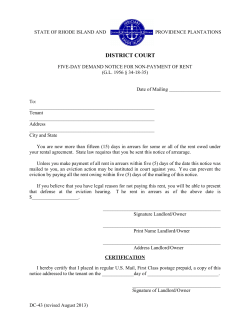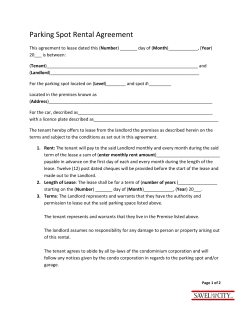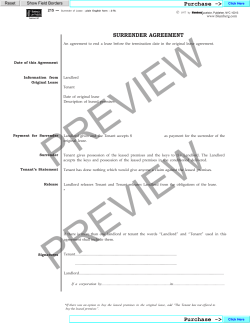
RESIDENTIAL EVICTION ACTIONS Introduction
RESIDENTIAL EVICTION ACTIONS Introduction These instructions apply to residential evictions governed by the Arizona Residential Landlord and Tenant Act. A.R.S. §§ 33-1301 – 33-1377. Additional guidance can be found in the Arizona Rules of Procedure for Eviction Actions (RPEA). These instructions do not apply to all types of residential tenancies. The applicable law governing renting a mobile home or a space in a mobile home park is the Arizona Mobile Home Parks Residential Landlord and Tenant Act. A.R.S. §§ 33-1401 – 33-1501. The Recreational Vehicle Long-Term Rental Space Act controls evictions concerning recreational vehicles. A.R.S. §§ 33-2100 – 33-2148. Evictions concerning hotels, motels and short-term boarding houses are governed by A.R.S. §§ 33-301 – 33-302. Eviction actions in connection with a real estate sales agreement are governed in part by A.R.S. § 33-742, et seq. (July 2013) 1 REVISED ARIZONA JURY INSTRUCTIONS (CIVIL), 5TH RESIDENTIAL EVICTION ACTIONS 1 Claims and Elements I will give you detailed instructions of law later in these instructions. But now I will give you a statement of each claim in the case. [Plaintiff/landlord] claims that [defendant/tenant] [breached a lease/violated the Arizona Residential Landlord and Tenant Act] and should be evicted. On this claim, the [plaintiff/landlord] must prove that there was a lease, that the [defendant/tenant] did not comply with the terms of that lease, that [defendant/tenant] was given the required written notice, [the alleged breach was not corrected within the time specified in the notice], and that the [plaintiff/landlord] [suffered monetary damages] and] is entitled to possession of the residence. [Defendant/tenant] claims (insert any affirmative defenses [Defendant/tenant] must prove (these defenses or counterclaims). or counterclaims). 1 SOURCE: A.R.S. §§ 33-1368; Rules of Procedure for Eviction Actions, hereinafter, “RPEA,” REPA 5 – 8; RAJI (CIVIL) 5TH (Contract 2, Claims and Elements). See generally Williams, Representing Residential Tenants in Eviction Actions, ARIZ. ATT’Y 12 (November 2011). USE NOTE: Use the language in the third section in cases where the defendant asserts an affirmative defense or counterclaim. (July 2013) 2 RESIDENTIAL EVICTION ACTIONS INSTRUCTIONS RESIDENTIAL EVICTION ACTIONS 2 Written Notice Before [plaintiff/landlord] can evict [defendant/tenant], [plaintiff/landlord] must first give [defendant/tenant] written notice. [Plaintiff/landlord] can provide this notice in person or by registered or certified mail to the [name of defendant/tenant’s] last known residence. By law, notice occurs the date that it is actually received or five days after it is mailed, whichever occurs first. In this case, [plaintiff/landlord] claims that the notice was provided to the tenant by [personal delivery, certified mail, registered mail]. [Defendant/tenant] claims that [he or she or they] [never received this notice]; [notice was improper]. 2 SOURCE: A.R.S. § 33-1368. USE NOTE: This instruction would need to be given if the tenant is claiming nonreceipt of the notice. While the sufficiency of the notice is a question of law., some circumstances may arise that also involve a question of fact (e.g., the notice did not contain the required information, the amount of rent requested in the notice was incorrect.) COMMENT: 1. Delivery of Notice. Every type of residential eviction action requires that the tenant first receive written notice and in most cases, an opportunity to cure. The landlord can provide this notice by hand delivery or by registered or certified mail to the tenant’s last known residence. By law, notice occurs the date that it is actually received or five days after it is mailed, whichever occurs first. A.R.S. § 33-1313(B). This statute does not apply to evictions following a trustee sale. 2. Types of Notices. The landlord must provide the tenant a five-day cure notice if the allegation is nonpayment of rent. A.R.S. § 33-1368(B). A five-day notice is also required if the landlord is alleging that the tenant committed a health or safety violation. A.R.S. § 33-1368(A). For something considered to be a material noncompliance (e.g. unauthorized occupants or pets), a ten-day notice is required. Id. If the landlord is requesting immediate possession due to allegations of a material and irreparable breach, then notice is still required but there is no cure period. Id. See also A.R.S. § 33-1331 (notice of foreclosure). PTFA requires 90 days’ notice and for notice to be personally served. See Residential Eviction Actions 7. (July 2013) 3 REVISED ARIZONA JURY INSTRUCTIONS (CIVIL), 5TH RESIDENTIAL EVICTION ACTIONS 3 Landlord Tenant Relationship [Plaintiff/landlord] claims that [defendant/tenant] violated a lease. A lease is an oral or written contract where someone with a right to possess a residence allows another to occupy it in exchange for rent. On this claim, [plaintiff/landlord] must prove that there was a lease with [defendant/tenant] and that [defendant/tenant] violated it. [Defendant/tenant] claims that there was no lease between the parties and that [defendant/tenant] [was a guest, boyfriend or girlfriend, etc.]. 3 SOURCE: A.R.S. § 33-1310(6) (landlord defined); A.R.S. § 33-1310(12) (rental agreement defined); A.R.S. § 33-1310(16) (tenant defined); A.R.S. § 33-1314 (terms and conditions of rental agreement); A.R.S. § 33-1377 (special detainer actions); RPEA 5. USE NOTE: The second section of this instruction would not need to be given unless the tenant contends that the parties were not in a landlord and tenant relationship. COMMENT: If the term of the lease is for less than one year (e.g. month to month), a lease agreement can be oral. A.R.S. § 44-101(6) (statute of frauds). A lease can be created for some type of valuable consideration other than rent (e.g. performing maintenance at an apartment complex) and in such a case, this instruction would need to be so tailored. (July 2013) 4 RESIDENTIAL EVICTION ACTIONS INSTRUCTIONS RESIDENTIAL EVICTION ACTIONS 4 Basis for Eviction (Breach of Lease) [Plaintiff/landlord] contends that [defendant/tenant] should be evicted. [Plaintiff/landlord] is requesting both money damages and possession of the residence. On this claim, [plaintiff/landlord] must prove that [defendant/tenant] materially breached the lease by [not paying the required rent on time, having an unauthorized occupant in the residence, etc.]. In response, [defendant/tenant] [denies the allegations, denies that the breach was material, asserts that rent was paid during the five-day period, asserts that the rent was not owed, asserts that there was a partial payment with no written agreement, asserts that there was an inadequate opportunity to cure, etc.]. 4 SOURCE: A.R.S. § 33-1368(C) (landlord’s damages); A.R.S. § 33-1377(D) (determining possession); RPEA 13(c)(2)(E) (plaintiff’s damages); RAJI (CIVIL) 5TH (Contract 9; Failure of Consideration, Material Breach). (July 2013) 5 REVISED ARIZONA JURY INSTRUCTIONS (CIVIL), 5TH RESIDENTIAL EVICTION ACTIONS 5 Measure of Direct Damages for a Prevailing Landlord If you find that [defendant/tenant] is liable to [plaintiff/landlord] for breaching the lease [and/or for violating the Arizona Residential Landlord and Tenant Act], you must then decide what amount of money to award [plaintiff/landlord]. A landlord may recover all reasonable damages resulting from the breach by the tenant with a rental agreement. To determine those damages, [plaintiff/landlord] must prove and you should determine the following: The amount of any accrued rent; and The amount of any accrued late fees; and [The amount of any accrued rental concessions]; [and] [The amount of any unpaid utilities; and] [Any other measurable damages caused by the defendant/tenant that result from a breach of the lease]. [A rental concession is a discount provided in the lease that becomes due and payable in the event the tenant violates the lease.] [If the [plaintiff/landlord] requested to be compensated for damages to property, then [plaintiff/landlord] must prove that this damage was [defendant/tenant’s fault]. This fault can be the result of an intentional action. This fault can also be the result of negligence. Negligence is the failure to act as a reasonably careful person would act under the circumstances. Negligence causes the damage if it helps produce the damage and if that damage would not have happened without the negligence.] 5 SOURCE: A.R.S. § 33-1314.01 (utility charges); A.R.S. § 33-1368(C) (landlord’s damages); RPEA 13(c)(2)(E) (plaintiff’s damages); RPEA 13(d) (rental concessions); RAJI (CIVIL) 5TH (Fault 1 and Fault 2). USE NOTE and COMMENT: The traditional measure for contract damages, putting the plaintiff in the position he would have been if the contract had been performed, does not apply in residential eviction actions in part because a landlord has a duty to mitigate damages by attempting to re-rent the dwelling. Tempe Corp. Office Bldg. v. Arizona Funding Services, Inc., 167 Ariz. 394, 339, 807 P.2d 1130, 1135 (Ct. App. 1991) (commercial lease). In addition, property damage claims usually cannot be determined until the landlord has possession of the residence again and then, any claim would be offset by the tenant’s security deposit. A.R.S. § 33-1321 (security deposits). There is an exception for property damages “when properly pled in the complaint and when such damages resulted from the breach giving rise to the eviction.” RPEA 13(c)(2)(E). (July 2013) 6 RESIDENTIAL EVICTION ACTIONS INSTRUCTIONS RESIDENTIAL EVICTION ACTIONS 6 Tenant’s Right to Reinstate the Lease for Non-Payment of Rent [Defendant/tenant] claims that the lease should continue because [he/she] paid [or tendered payment in] the required amount after he/she received a five-day notice. To establish this defense, [defendant/tenant] must prove he/she paid [tendered] the full amount due. 6 SOURCE: A.R.S. § 33-1368(B) (sets forth requirements for a tenant to reinstate the lease upon receipt of the five-day notice and after an eviction action has been filed). USE NOTE: Arizona is a “pay and stay” jurisdiction. In nonpayment of rent cases only, the tenant can pay all of the rent and any late fees any time before the lawsuit is filed and avoid eviction. If the eviction action has been filed, then the tenant must pay all past due rent, late fees, attorney’s fees and court costs. If the tenant does so literally anytime before a judgment is entered, he or she can avoid eviction. However, after a judgment has been entered, reinstatement of the lease is solely in the landlord’s discretion. A.R.S. § 33-1368(B); Keenen v. Biles, 199 Ariz. 266, 268, 17 P.3d 111, 113 (Ct. App. 2001) (Landlord can obtain judgment for rent, costs and attorney fees where property was returned to possession of landlord after special detainer action was filed, but prior to the award of judgment.). (July 2013) 7 REVISED ARIZONA JURY INSTRUCTIONS (CIVIL), 5TH RESIDENTIAL EVICTION ACTIONS 7 Bona Fide Lease Defense Following a Trustee’s Sale After a trustee’s sale, the new owner is prohibited from evicting any existing tenants in certain situations. If an existing tenant wishes to keep possession of the property following a trustee’s sale, the existing tenant must prove that a “bona fide” lease was in place at the time of the trustee’s sale. To qualify as a “bona fide” lease, [defendant/tenant] must prove: 1. That the lease was entered into before the trustee’s deed is delivered; 2. That the tenant is not the defaulting borrower; 3. That the lease is the result of an arm’s length transaction; and 4. That the lease requires an amount of rent that is not substantially less than the “fair market rent” for the property. An arm’s length transaction is an agreement between two parties who are not related to each other and who are not on close terms with each other. 7 SOURCE: The Protecting Tenants at Foreclosure Act of 2009 (PTFA), Pub. L. No. 111-22, Sec. 702, 123 Stat. 1660 (2009), 12 U.S.C. § 5220; Bank of New York Mellon v. De Meo, 227 Ariz. 192, 254 P.3d 1138 (Ct. App. 2011) (purchaser at trustee’s sale was required to provide 90 days actual notice to vacate to tenant even though eviction action hearing did not occur until 97 days after five-day notice). BLACK’S LAW DICTIONARY, 103 (1999) (arm’s length transaction). See also Dewey v. Arnold, 159 Ariz. 65, 70, 764 P.2d 1124, 1129 (1988) (Contains a discussion of arm’s length transactions). An amendment to the PTFA provided that “the date of a notice of foreclosure shall be deemed to be the date on which complete title to a property is transferred to a successor entity or person as a result of an order of a court or pursuant to provisions in a mortgage, deed of trust, or security deed.” Pub. L. 111-203, Title XIV, § 1484(1), 124 Stat. 2204 (2010); 12 U.S.C.A. § 5220, note. See also Logan v. U.S. Bank Nat’l Ass’n, ___ F.3d ___, 2013 WL 3614465 (9th Cir. 2013) (PFTA does not provide a right of action). COMMENT: Under the PTFA, if a “bona fide” lease exists, then the new owner is required to honor the lease unless the new owner intends to occupy the property as their primary residence. If the new owner intends to occupy the property as their primary residence, then the new owner must provide the tenant with 90-days notice to vacate. The effect of foreclosure on Section 8 tenancies is governed by amendments to the United States Housing Act of 1937. See generally 42 U.S.C. § 1437(f). See also Curtis v. Morris, 186 Ariz. 534, 925 P.2d 259 (1996) (An eviction action can be used to obtain possession of property after a trustee’s sale.). (July 2013) 8 RESIDENTIAL EVICTION ACTIONS INSTRUCTIONS RESIDENTIAL EVICTION ACTIONS 8 Tenant’s Counterclaim/Defense Concerning a Diminution in Value [Defendant/tenant] claims that [he/she] [withheld rent or is due a refund from rent paid] because [plaintiff/landlord] did something to diminish the rental value of the property. A tenant cannot withhold rent unless [he/she] can prove all of the following: 1. That [plaintiff/landlord] deliberately or negligently failed to supply [running water, gas, electrical service, reasonable amounts of hot water or heat, air-conditioning or cooling or other essential service]; and 2. That [defendant/tenant] gave notice of this condition to [plaintiff/landlord]; and 3. That [plaintiff/landlord] failed to cure this condition within five days; and 4. That this condition was not caused by the deliberate or negligent act or omission of [defendant/tenant], a member of the [defendant/tenant’s] family or other person on the premises with the [defendant/tenant’s] consent. [Negligence is the failure to act as a reasonably careful person would act under the circumstances. Negligence causes the damage if it helps produce the damage and if that damage would not have happened without the negligence.] 8 SOURCE: A.R.S. § 33-1364(A)(2) (diminution in value); A.R.S. § 33-1368(B) (prohibits unauthorized withholding of rent by tenants); A.R.S. § 33-1364(A) (list of essential services); A.R.S. § 33-1364(H) (notice requirement); A.R.S. § 33-1365 (landlord’s noncompliance as defense); RPEA 8; RAJI (CIVIL) 5TH (Fault 1 and Fault 2). USE NOTE and COMMENT: Tenants cannot withhold rent simply because they are having a disagreement with their landlord. A.R.S. § 33-1368(B). For minor repairs, a tenant can notify the landlord of his intention to repair the problem at the landlord’s expense. A.R.S. § 33-1363. If the landlord does not fix the condition within ten days from receiving the notice, the tenant can hire a licensed contractor, submit a repair bill to the landlord, and deduct the cost of the work from his rent. Id. For something that qualifies as an essential service, the tenant has several options, including finding substitute housing (e.g. a motel), during the period of the landlord’s noncompliance. A.R.S. § 33-1364. For an essential service, the landlord only has five days to fix the condition after receiving notice. A minor repair could be the basis of a counterclaim, but it could not be the basis for a diminution in value claim. (July 2013) 9 REVISED ARIZONA JURY INSTRUCTIONS (CIVIL), 5TH RESIDENTIAL EVICTION ACTIONS 9 Tenant’s Counterclaim for Misconduct by Landlord (Abuse of Access) [Defendant/tenant] claims that [he/she] is entitled to damages because [plaintiff/landlord] abused his/her right of access by [wrongfully entering the residence without giving two days notice][making repeated demands for entry to the point that it had the effect of unreasonably harassing him/her]. If [defendant/tenant] proves this allegation, then [defendant/tenant] is entitled to damages in an amount equal to at least one month’s rent. 9 SOURCE: A.R.S. §§ 33-1343D, 33-1376 (tenant’s remedies for abuse of access). COMMENT: If the tenant requests that the landlord provide maintenance to the residence, then the tenant waives receipt of any separate two-day advance notice, as long as the entry into the residence is limited to the purpose of the maintenance request. A.R.S. § 33-1342(B). (July 2013) 10 RESIDENTIAL EVICTION ACTIONS INSTRUCTIONS RESIDENTIAL EVICTION ACTIONS 10 Tenant’s Counterclaim for Misconduct by Landlord (Unlawful Ouster, Exclusion, Diminution of Services, Retaliatory Eviction) [Defendant/tenant] claims that [he/she] is entitled to damages because [plaintiff/landlord] [did one or more of the following]: [Unlawfully prohibited access to the residence] and/or [Willfully cut off electric, gas, or water services to the residence] and/or [Retaliated because the tenant (1) Complained to a government agency about the landlord, (2) Complained to the landlord concerning a failure to maintain a fit premises, and/or (3) Joined a tenants’ organization. Evidence of a complaint within six months before the alleged act of retaliation creates a presumption that the landlord’s conduct was done in retaliation. This presumption does not apply if the tenant made the complaint after receiving notice that the lease was being terminated.] If [defendant/tenant] proves this allegation, then [defendant/tenant] is entitled to damages in an amount equal to two month’s rent or twice the actual damages sustained, whichever is greater. 10 SOURCE: A.R.S. § 33-1367 (tenant’s remedies for landlord’s unlawful ouster, exclusion of services); A.R.S. § 33-1381 (retaliatory eviction). COMMENT: While locking out a tenant is a common practice in commercial lease settings, there are substantial penalties for doing so in a residential context. USE NOTE: If multiple counterclaims are proven, a tenant is entitled to damages for each counterclaim. (July 2013) 11 REVISED ARIZONA JURY INSTRUCTIONS (CIVIL), 5TH VERDICT FORM (RESIDENTIAL EVICTION ACTION) JUDGMENT FOR LANDLORD – FORM 1 (Use if You Find for the Plaintiff and There Is No Counterclaim) We, the Jury, duly empaneled and sworn in the above entitled action, upon our oaths, do find in favor of [name of plaintiff/landlord] as follows: That the full damages to be $_______________; and That [name of plaintiff/landlord] is entitled to possession of the rental property. 1. 5. 2. 6. 3. 7. 4. FOREPERSON (July 2013) 12 VERDICT FORM (RESIDENTIAL EVICTION ACTION) JUDGMENT FOR TENANT – FORM 2 (Use if You Find for the Tenant and There Is No Counterclaim) We, the Jury, duly empaneled and sworn in the above entitled action, upon our oaths, do find in favor of [name of defendant/tenant] and find that the [name of defendant/tenant] is entitled to possession of the rental property. 1. 5. 2. 6. 3. 7. 4. FOREPERSON (July 2013) 13 VERDICT FORM (RESIDENTIAL EVICTION ACTION) JUDGMENT WITH COUNTERCLAIM – FORM 3 We, the Jury, duly empaneled and sworn in the above entitled action, upon our oaths, do find as follows: That the full damages for the [plaintiff/landlord] to be $_______________; and That the full damages for the [defendant/tenant] to be $_______________; and That the landlord/the tenant (circle one) is entitled to possession of the rental property. [Note: If they jury finds that a party should receive no amount of money, then put a zero in the above blank for that party]. 1. 5. 2. 6. 3. 7. 4. FOREPERSON (July 2013) 14
© Copyright 2025









